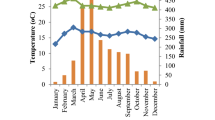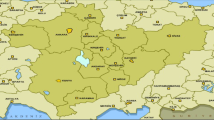Abstract
A crop rotation system can reduce phytopathogen inoculum, and consequently reduce the incidence and severity of disease. Bean bacterial wilt is an important disease and several crops can act as inoculum sources for Curtobacterium flaccumfaciens pv. flaccumfaciens (Cff). The aim was to evaluate the influence of crop rotation systems on 10 common bean cultivars against bacterial wilt. Experiments were located in two different areas in Brazil (2012), cultivated under a no-tillage system and with a history of the disease. The evaluated rotation systems were black oat, wheat and fallow followed by common bean. After harvest, 10 dry bean cultivars were sown, together with a fallow area. Disease incidence and severity were assessed at 45, 60 and 80 days after sowing. Also evaluated were four agronomical parameters: pod numbers, grain numbers, total weight of grains per plant and weight of 100 grains. Epiphytic and endophytic colonization by Cff was evaluated in black oat and wheat, and in crop debris. The rotation systems significantly influenced the incidence and severity of bacterial wilt in common bean cultivars in both areas and negatively affected the four agronomic parameters. The cultivars BRS Campeiro, BRS Estilo, IPR Tuiuiú, IPR Tangará and IPR Campos Gerais presented low severity and incidence of the disease and higher productivity. Cff strains were recovered from black oat, wheat and crop debris. Our results reinforce the importance of planting non-Cff host crops in rotation systems with common bean, as well as planting cultivars with a level of resistance to bacterial wilt.



Similar content being viewed by others
References
Agrofit (2012). Sistema de agrotóxicos fitossanitários. http://agrofit.agricultura.gov.br/agrofit_cons/principal_agrofit_cons/. Accessed 5 Feb 2020.
Bullock, D. G. (1992). Crop rotation. Critical Reviews in Plant Sciences. https://doi.org/10.1080/07352689209382349.
Collins, M. D., Jones, D. (1983). Reclassification of corynebacterium flaccumfaciens, corynebacterium betae, corynebacterium oortii and corynebacterium poinsettiae in the genus curtobacterium, as curtobacterium flaccumfaciens comb. nov.. Microbiology 129 (11):3545–3548
Gonçalves, R. M., Schipanski, C. A., Koguishi, L., Soman, J. M., Sakate, R. K., Júnior, T. A. F. S., & Maringoni, A. C. (2017). Alternative hosts of Curtobacterium flaccumfaciens pv. flaccumfaciens, causal agent of bean bacterial wilt. European Journal of Plant Pathology. https://doi.org/10.1007/s10658-016-1094-4.
Gonçalves, R. M., Soman, J. M., Krause Sakate, R., Passos, J. R. S., Silva Júnior, T. A. F., & Maringoni, A. C. (2018a). Survival of Curtobacterium flaccumfaciens pv. flaccumfaciens in the soil under Brazilian conditions. European Journal of Plant Pathology. https://doi.org/10.1007/s10658-018-1466-z.
Gonçalves, R. M., Balbi-Peña, M. I., Soman, J. M., & Maringoni, A. C. (2018b). Genetic diversity of Curtobacterium flaccumfaciens revealed by multilocus sequence analysis. European Journal of Plant Pathology. https://doi.org/10.1007/s10658-018-01648-0.
Hardoim, P. R., van Overbeek, L. S., Berg, G., Pirttilä, A. M., Compant, S., Campisano, A., et al. (2015). The hidden world within plants: Ecological and evolutionary considerations for defining functioning of microbial endophytes. Microbiology and Molecular Biology Reviews. https://doi.org/10.1128/mmbr.00050-14.
Harveson, R. M., Schwartz, H. F., Urrea, C. A., & Yonts, C. D. (2015). Bacterial wilt of dry-edible beans in the central high plains of the U.S.: Past, present, and future. Plant Disease, https://doi.org/10.1094/PDIS-03-15-0299-FE.
Maringoni, A. C. (2002). Comportamento de cultivares de feijoeiro comum à murcha-de-curtobacterium. Fitopatologia Brasileira. https://doi.org/10.1590/S0100-41582002000200006.
Maringoni, A. C., & Camara, R. D. C. (2006). Curtobacterium flaccumfaciens pv. flaccumfaciens detection in bean seeds using a semi-selective culture medium. Brazilian Journal of Microbiology, https://doi.org/10.1590/S1517-83822006000400009.
Maringoni, A. C., Ishiszuka, M. S., Silva, A. P., Soman, J. M., Moura, M. F., Santos, R. L., et al. (2015). Reaction and colonization of common bean genotypes by Curtobacterium flaccumfaciens pv. flaccumfaciens. Crop Breeding and Applied Biotechnology. https://doi.org/10.1590/1984-70332015v15n2a16.
Nascimento, D. M., Oliveira, L. R., Melo, L. L., Silva, J. C., Soman, J. M., Girotto, K. T., Eburneo, R. P., Ribeiro-Junior, M. R., Sartori, M. M. P., Silva Júnior, T. A. F., & Maringoni, A. C. (2020). Survival of Curtobacterium flaccumfaciens pv. flaccumfaciens in weeds. Plant Pathology. https://doi.org/10.1111/ppa.13206.
Naseri, B. (2014). Bean production and fusarium root rot in diverse soil environments in Iran. Journal of Soil Science and Plant Nutrition. https://doi.org/10.4067/S0718-95162014005000014.
Negash, F., Mulualem, T., & Fikirie, K. (2018). Effect of cropping sequence on agricultural crops: Implications for productivity and utilization of natural resources. Advances in Crop Science and Technology. https://doi.org/10.4172/2329-8863.1000326.
Osdaghi, E., Young, A. j., & Harveson, R. M. (2020). Bacterial wilt of dry beans caused by Curtobacterium flaccumfaciens pv. flaccumfaciens: A new threat from an old enemy. Molecular Plant Pathology. https://doi.org/10.1111/mpp.12926.
Raij, B., Cantarella, H., Quaggio, J. A., Furlani, A. M. (1996). Recomendação de adubação e calagem para o estado de São Paulo. Campinas: Boletim Técnico IAC no 100.
Rastogi, G., Coaker, G. L., & Leveau, J. H. J. (2013). New insights into the structure and function of phyllosphere microbiota through high-throughput molecular approaches. FEMS Microbiology Letters. https://doi.org/10.1111/1574-6968.12225.
Reinhold-Hurek, B., & Hurek, T. (2011). Living inside plants: Bacterial endophytes. Current Opinion in Plant Biology. https://doi.org/10.1016/j.pbi.2011.04.004.
Schaad, N. W., Jones, J. B., & Chun, W. (2001). Laboratory guide for identification of plant pathogenic Bacteria (3rd ed.). Saint Paul: APS Press.
Schwartz, H. F., Steadman, J. R., Hall, R., & Forster, R. L. (2005). Compendium of bean diseases (2nd ed.). Saint Paul: APS.
Shaner, G., & Finney, R. E. (1977). The effect of nitrogen fertilization on the expression of slow-mildewing resistance in Knox wheat. Phytopathology, 67, 1051–1056.
Silva Júnior, T. A. F., Negrao, D. R., Itako, A. T., & Maringoni, A. C. (2012a). Pathogenicity of Curtobacterium flaccumfaciens pv. flaccumfaciens to several plant species. Journal of Plant Pathology, 94(2), 427–430.
Silva Júnior, T. A. F., Negrão, D. R., Itako, A. T., Soman, J. M., & Maringoni, A. C. (2012b). Survival of Curtobacterium flaccumfaciens pv. flaccumfaciens in soil and bean crop debris. Journal of Plant Pathology. https://doi.org/10.4454/JPP.FA.2012.025.
Souza, V. L., & Maringoni, A. C. (2008). Análise ultraestrutural da interação de Curtobacterium flaccumfaciens pv. flaccumfaciens em genótipos de feijoeiro. Summa Phytopathologica. https://doi.org/10.1590/S0100-54052008000400003.
Tegli, S., Sereni, A., & Surico, G. (2002). PCR-based assay for the detection of Curtobacterium flaccumfaciens pv. Flaccumfaciens in bean seeds. Letters in Applied Microbiology. https://doi.org/10.1046/j.1472-765X.2002.01187.x.
Theodoro, G. F., & Maringoni, A. C. (2006). Murcha-de-curtobacterium do feijoeiro no Estado de Santa Catarina e reação de genótipos a Curtobacterium flaccumfaciens pv. flaccumfaciens. Summa Phytopathologica. https://doi.org/10.1590/S0100-54052006000100005.
Theodoro, G. F., & Maringoni, A. C. (2010). Bacterial wilt of common bean. In M. D. Pria & O. C. Silva (Eds.), Cultura do Feijão: doenças e controle (pp. 23–30). Paraná: UEPG.
van Bruggen, A. H. C., Gamliel, A., & Finckh, M. R. (2016). Plant disease management in organic farming systems. Pest Management Science. https://doi.org/10.1002/ps.4145.
Vorholt, J. A. (2012). Microbial life in the phyllosphere. Nature Reviews Microbiology. https://doi.org/10.1038/nrmicro2910.
Wendland, A., Moreira, A. S., Bianchini, A., Giampan, J., & Lobo Junior, M. (2016). Doenças do feijoeiro. In L. Amorim, J. A. M. Rezende, A. Bergamin Filho, & L. E. A. Camargo (Eds.), Manual de Fitopatologia: doenças de plantas cultivadas (5th ed., pp. 383–396). São Paulo: Ceres.
Zinniel, D. K., Lambrecht, P., Harris, N. B., Feng, Z., Kuczmarski, D., Higley, P., et al. (2002). Isolation and characterization of endophytic colonizing Bacteria from agronomic crops and prairie plants. Applied and Environmental Microbiology, https://doi.org/10.1128/AEM.68.5.2198-2208.2002.
Acknowledgements
The authors thank the Coordination for the Improvement of Higher Education Personnel (CAPES) and the ABC Fundation (Fundação ABC) for the financial support.
Author information
Authors and Affiliations
Corresponding author
Ethics declarations
Conflict of interest
All authors declare no conflict of interest.
Human and animal rights
No human and/or animal participants were involved in this research.
Informed consent
All authors consent to this submission.
Rights and permissions
About this article
Cite this article
Gonçalves, R.M., da Silva Júnior, T.A.F., Soman, J.M. et al. Effect of crop rotation on common bean cultivars against bacterial wilt caused by Curtobacterium flaccumfaciens pv. flaccumfaciens. Eur J Plant Pathol 159, 485–493 (2021). https://doi.org/10.1007/s10658-020-02176-6
Accepted:
Published:
Issue Date:
DOI: https://doi.org/10.1007/s10658-020-02176-6




